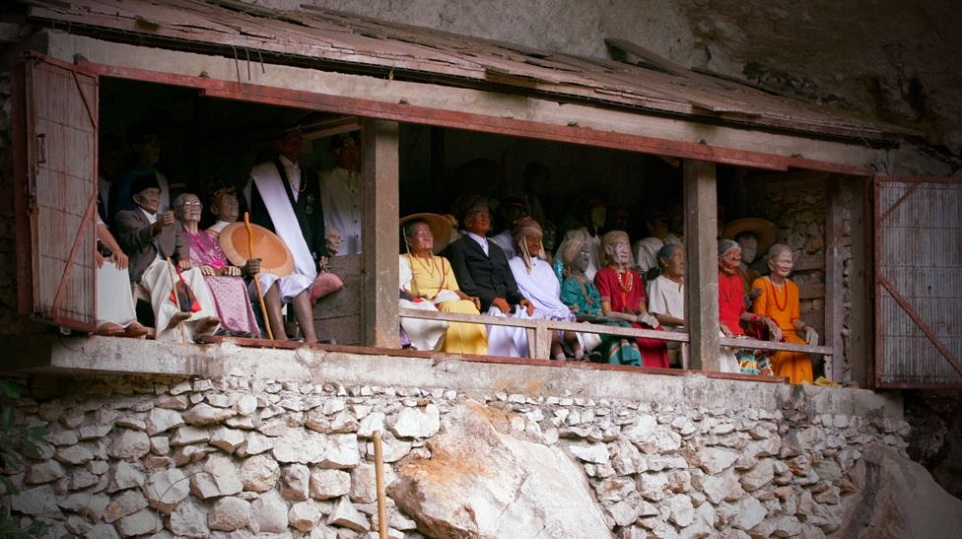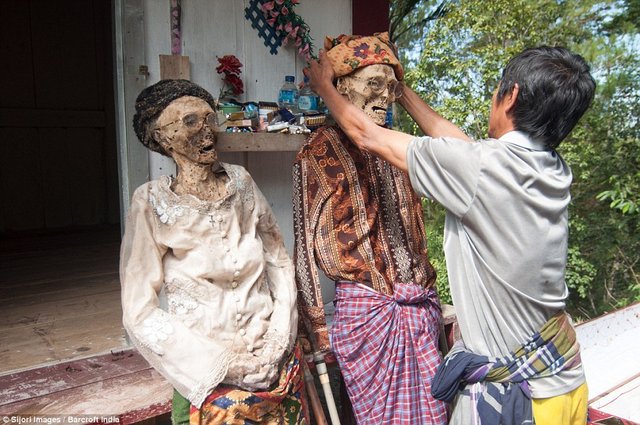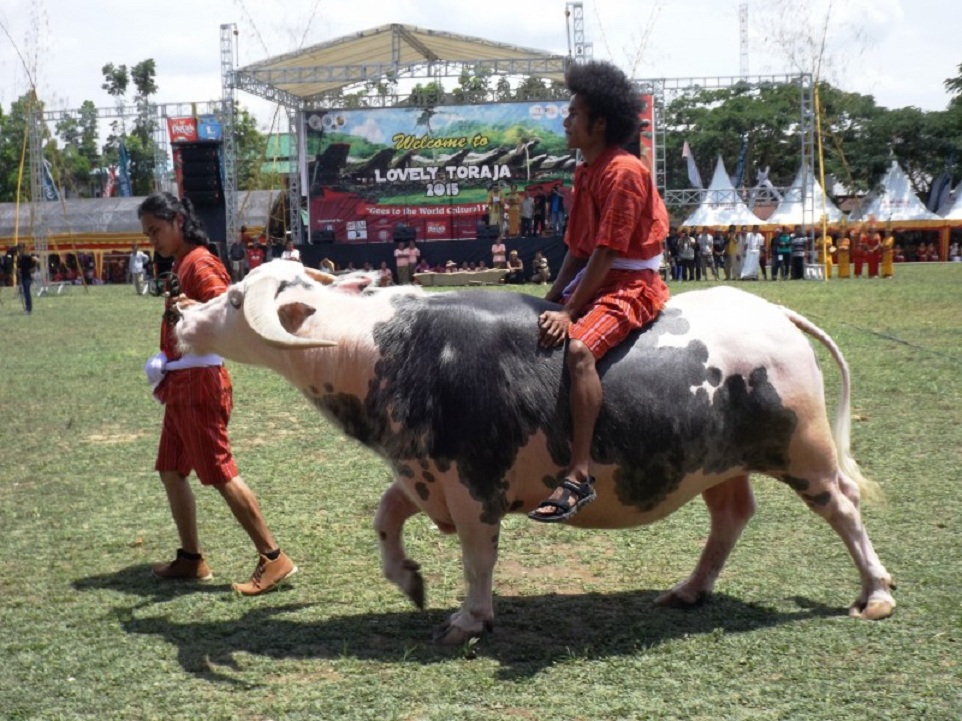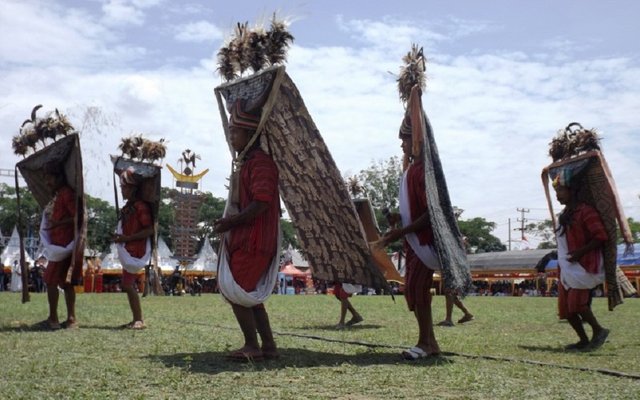The Toraja is an indigenous tribe residing in the South Sulawesi region of Indonesia. The population of the Toraja Tribe ranges from 1,100,000 to 1,200,00 with half of them living in the Toraja mainland and half in other areas of Indonesia. The Toraja people speak many variants of a local language called Toraja. Some of these variants include Mamasa, Kalumpang, Talondo, Tae, Toraja-sa’adan, and Toala. The national language of Indonesia is also spoken and learned in Toraja schools but the medium of education is their mother tongue.

Image Source:http://www.bbc.com
Origin
There are two theories prevailing regarding the origin of the Toraja tribe.
The Toraja folklore says that Toraja people came down to the Earth from the sky. This theory cannot be accepted by
experts because it is far from the reality.According to most of the experts, the ancestors of the Toraja tribe were sailors who sailed from South China sea in around 2000 to 3000 BC. The sailors occupied the mountainous Sulawesi region which became the heartland of the Toraja people later on. The Toraja independence ended after an armed struggle between the Tribe and the mighty Dutch. The Dutch unified both the highland and lowland Sulawesi and started mass conversion of the tribesmen into Christianity. Though most of the Torja showed extreme resistance and continued following their religion yet some of them converted to Christianity for one or other reason.
Religion
Though most of the Toraja people have either converted to Christianity or Islam yet their indigenous religion is animism. A major portion of the tribe still practices this unique religion which is known as Aluk Do Tolo or “the way”. The “Aluk Do Tolo” combines ancestor worshipping, myths and different rituals in a blend. According to their belief, the world is divided into three parts: the upper world or heaven, the middle world or earth, and the underworld. The Toraja people say that their ancestors came down from the sky to the middle world (earth) via stairs which helped Toraja communicate with the God. The houses made by the Toraja people resemble the spaceships that brought their ancestors to earth. The Toraja people consider it their responsibility to sacrifice animals in honor of their ancestors who provide protection and blessings to the tribe members.
Code of Conduct
- Living with the dead
Unlike other people, the Toraja people have a centuries-old unique custom of keeping dead bodies of their beloved ones in their homes. The religious beliefs of the tribe blur the line between the worldly life and the heaven. When a person dies in the tribe, his/her body is kept in a separate room for months or even years before the funeral. The tribe members are supposed to take care of the dead bodies to make them happy and to safeguard themselves and their families from any harm inflicted by the deceased. It is considered the duty of the relatives of the dead person to bring him/her food, drinks, juices, cigarettes and other daily life commodities. Even a special portion of the room is dedicated to being the bathroom for the deceased person. According to their religious belief, funerals serve as the final journey towards the last phase of the afterlife which is called Pooya. Buffaloes are considered to be the soul-carrier towards Pooya and hence have to be sacrificed in a large number to make the journey easy. For this purpose, the tribe members strive to accumulate a lot of wealth to buy as many buffaloes as they can to make the journey of their beloved ones pleasant. Instead of burying their dead in the ground, these people would place the dead bodies in the caves of mountains and daily life commodities are carried to their destination on the periodic basis to keep the souls happy. Another interesting part of their tradition is the way they treat the dead nobles. Noble people of the Toraja are decorated with clothes, jewelry, and other things and special seats are designed for them to look upon the tribe from those seats. The dead bodies irrespective of their caste or gender etc are paraded every year in a celebration called “ma’nene” or “cleansing of the corpses”. The “ma’nene” celebrations serve many purposes such as family reunion, a reunion of dead people and as a photo-taking ceremony of the people with their ancestors and beloved ones.

Image Source:http://www.dailymail.co.uk
- Slavery
The Toraja Tribe is normally divided into three classes: aristocrats, commoners and the slaves. This division of classes means that the Toraja Tribe is still not free from the shackles of slavery. Slaves are not allowed to marry women of higher classes or even to touch the utensils in which people of higher classes eat or drink.
- Joint family system
The Toraja people live in joint families with grandparents, parents, aunts, uncles and their children. Every person irrespective of the age is expected to do his/her own portion of the household chore and asked to respect the elders. This joint family system in the Toraja tribe is called Rabaku. The children and grandchildren are given their fair share in the inheritance but the amount of land they receive varies depending upon the number of water buffaloes they sacrifice at the funeral of their parents or grandparents.
- Classification of the Toraja tribe into classes
As already discussed, the Toraja tribe is divided into three major classes: Wealthy people, commoners, and slaves. Aristocrats are the head of the tribe, commoners are second in grade to them and slaves are considered untouchables. They are not allowed to touch people or marry women of higher classes.
- Classification of duties in a family
In the Toraja tribe, the duties are assigned according to the age of a person. Females mostly are considered to be responsible for household chores with males helping in taking care of the babies. Males work in the fields or do fishing but helped by the females too. Children are raised by the parents and elder siblings. Adoption of children is also very common in Toraja tribe with children giving equal respect to their biological and adoptive parents.
- Monogamy
The Toraja people mostly practice monogamy i-e they have single wives with exception of polygamy in rich families. In the Toraja tribe, most of the marriages are arranged, however, love marriages are also not very rare.
- Sexual customs
In the Toraja tribe, both males and females start having sexual relations at a very early age and most of the people have several partners before getting married. There is a unique tradition in the Toraja tribe that when a girl is in the mood of love, she has to walk around the rice fields and has to scream loud until she finds a suitable person to have a romance with. Some of the people in the tribe get their nicknames based on the sexual powers they have.
Tribal Traits
- Water Buffalo as a symbol of wealth
Water buffalo is considered a symbol of power in the Toraja tribe. Hundreds of water buffaloes are sacrificed at the funeral ceremonies and anyone sacrificing more buffaloes gets more inheritance of the ancestors.

Image Source:https://globalvoices.org
- Unique houses
The Toraja houses are as unique as the tribe is unique in itself. There are many theories about the shapes of their houses. Some say that the houses represent the heads and horns of the water buffaloes which is a symbol of prestige in the Toraja tribe. Other say that these houses represent boats which the Toraja would use to reach Sulawesi through the river. There is also another interesting theory about the shapes of houses and that is the houses symbolize the spaceships which their ancestors used to come to earth from the sky according to their belief. The Toraja houses are oriented towards north direction because they believe that their ancestors came from the north towards Sulawesi. The Toraja houses normally have buffaloes and cocks on top of them. The Buffaloes are a sign of worldly prestige as already discussed and cocks are a symbol of the hereafter.
Clothes
It is considered offensive in the Toraja tribe if anyone shows off his/her body. The males wear daggers which are attached to the back of their sarong (a type of shirt people use to wear in East Asia). Women, on the other hand, wear colorful dresses with a lot of decorations on them. Both men and women wear long pants with sleeves too. Women are also free to wear skirts. Normally, Toraja people wear flip-flop on their feet, however, rich people prefer to wear leather shoes instead. The Western clothes are also highly popular in the young generation of the Toraja people.
Food
Rice is one of the most favorite foods of the Toraja people. Buffaloes and pigs are slaughtered and eaten as a part of
their diet. Some of the Toraja people also eat dog’s meat. Fish and eels are also raised in fish ponds and rice fields and many of the Toraja traders also bring fish from the nearby rivers to sell in the Toraja area. Toraja people also eat sweet foods like cakes made from rice, treacle, and peanuts wrapped in corn leaves and sticky sugar rice etc. Palm juice mixed with sugar is a major drink in the Toraja community. All the foods and juices are prepared and sold in the Bamboo tubes.
Music
Music and dance are an important part of the Toraja life. Unlike other societies in which dance is considered a part of the happy occasion, the Toraja people also dance during the funeral ceremonies. The purpose of their music and dance is not only to express their grief on the departure of the beloved ones but also to cheer up their journey towards their final destination. The tribe members chants, clap their hands and read songs aloud on the tune of musical instruments. Music is played and dances are performed on many other occasions like harvesting time of crops and to get spiritual blessings. Some of the musical instruments used by the Toraja people to play tune are bamboo flute, Pa’pelle, and Pa’karombi. The bamboo flute is made from bamboo plant, Pa’ pelle is made from palm leaves, and pa’karombi is made from the metals.
Ceremonies
Some of the interesting ceremonies arranged by the Toraja tribe are as follows:
As already discussed, death ceremonies mark the most important events in the life of Toraja. The dead bodies are washed and paraded throughout the area to mark their reunion with the tribe members and other dead people. This type of ceremony is called “ma’nene”. A lot of cows are slaughtered depending upon the wealth-status of the family. A cockfight also takes place on the occasion to bring blessings to the soul as cockfighting and spilling of blood is considered sacred in the tribe. During funeral ceremony, the Toraja people dance and chants slogans to honor the dead. On the second day, another special dance is performed and on the last day, old women praise the loyalty and honesty of the deceased person. The Toraja tribe also performs a special kind of dance on the harvesting of crops and on Thanksgiving. The Aluk religion dictates that when and how the Toraja people have to dance.

Image Source:https://globalvoices.org
Very interesting article on toraja. This tribe has very strange traditions as compared to Asian culture but no doubt they have their colors too.
Very sound and informative article
Downvoting a post can decrease pending rewards and make it less visible. Common reasons:
Submit
Thank you so much@ironclad010.
Downvoting a post can decrease pending rewards and make it less visible. Common reasons:
Submit
@resteemator is a new bot casting votes for its followers. Follow @resteemator and vote this comment to increase your chance to be voted in the future!
Downvoting a post can decrease pending rewards and make it less visible. Common reasons:
Submit
Following already, sir.
Downvoting a post can decrease pending rewards and make it less visible. Common reasons:
Submit
Good morning friend, I loved that photograph!!! @mmasim. Greetings ; )
Downvoting a post can decrease pending rewards and make it less visible. Common reasons:
Submit
Thank you so much, sir.
Downvoting a post can decrease pending rewards and make it less visible. Common reasons:
Submit